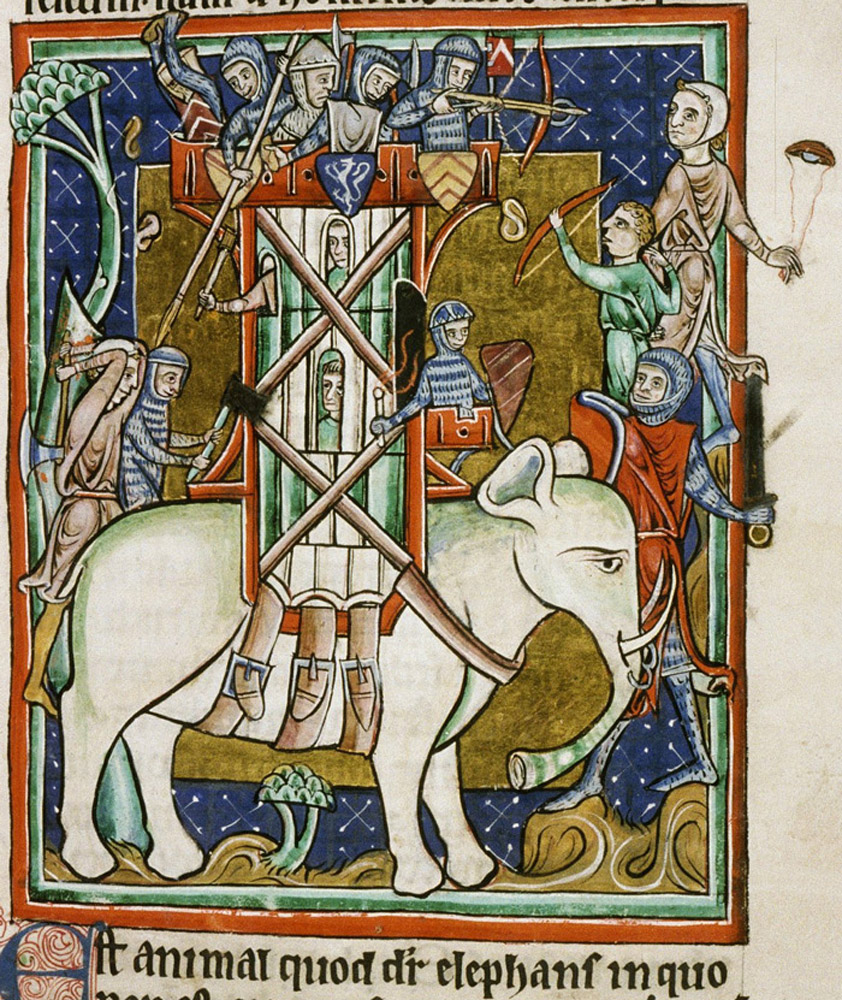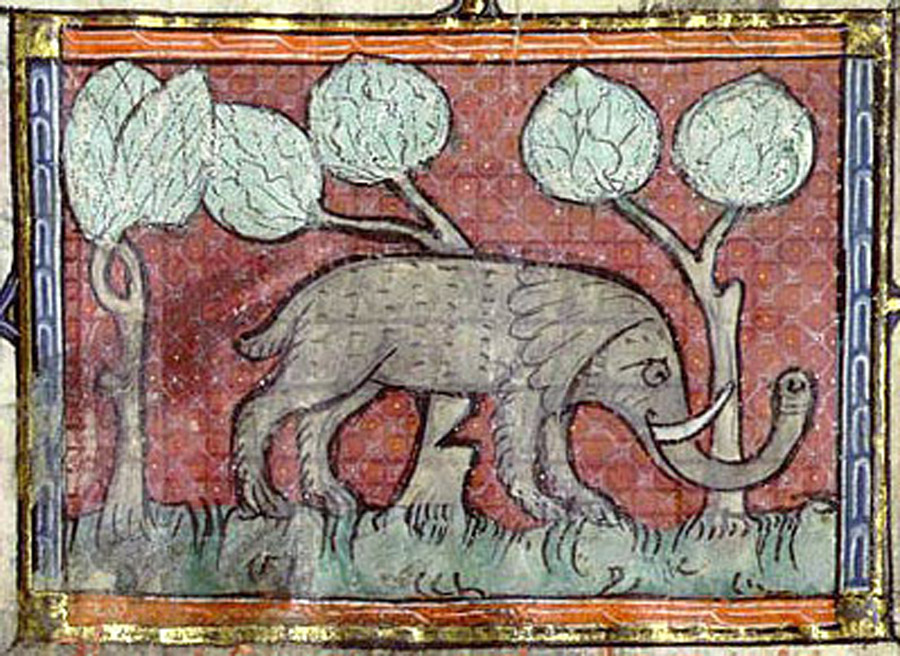
Hugh of Fouilloy (SloaneMS). Elephants, Dragon, and Mandragora.

Bodleian: In India, soldiers fight from a castle mounted on the back of an elephant. The tusks of the elephant come out of its trunk rather than its mouth.

Bibliothèque Nationale de France, fr. 1951, Folio 19r. An elephant leans on a partially cut through tree.
Text Translation:
[Of the elephant] … no larger animal is seen. The Persians and Indians, carried in wooden towers on their backs, fight with javelins as from a wall. Elephants have a lively intelligence and a long memory; they move around in herds; they flee from a mouse; they mate back-to-back. The female is pregnant for two years, and gives birth no more than once, and not to several offspring but to one only. Elephants live for three hundred years. If an elephant wants to father sons, it goes to the East, near Paradise; there the tree called mandragora, the mandrake, grows. The elephant goes to it with his mate, who first takes fruit from the tree and gives it to her male. And she seduces him until he eats it; then she conceives at once in her womb. When the time comes for her to give birth, she goes out into a pool, until the water comes up to her udders. The male guards her while she is in labour, because elephants have an enemy – the dragon. If the elephant finds a snake, it kills it, trampling it until it is dead. The elephant strikes fear into bulls, yet fears the mouse. The elephant has this characteristic: if it falls down, it cannot rise. But it falls when it leans on a tree in order to sleep, for it has no joints in its knees. A hunter cuts part of the way through the tree, so that when the elephant leans against it, elephant and tree will fall together. As the elephant falls, it trumpets loudly; at once a big elephant goes to it but cannot lift it. Then they both trumpet and twelve elephants come, but they cannot lift the one who has fallen. Then they all trumpet, and immediately a little elephant comes and puts its trunk under the big one and lifts it up. The little elephant has this characteristic, that when some of its hair and bones have been burnt, nothing evil approaches, not even a dragon. The big elephant and its mate represent Adam and Eve. For when they were in the flesh pleasing to God, before their sin, they did not know how to mate and had no understanding of sin. But when the woman ate the fruit of the tree, that is to say, she gave her man the fruit of the mandrake, the tree of knowledge, then she became pregnant, and for that reason they left Paradise. For as long as they were in Paradise, Adam did not mate with Eve. For it is written: ‘Adam knew his wife and she conceived’, (Genesis, 4:1) and she gave birth on the waters of guilt. Of this, the prophet says: ‘Save me, O God, for the waters are come in unto my soul.'(Psalms, 69:1). And at once the dragon seduced them and caused them to be outcasts from their citadel, that is, because they displeased God.
Then came the big elephant, meaning the law, and did not raise up mankind, any more than the priest raised the man who fell among thieves. Nor did the twelve elephants, that is, the company of prophets, raise mankind, just as the Levite did not raise the wounded man we spoke of. But the elephant capable of understanding, that is our Lord Jesus Christ, who, although greater than all, became the smallest of all, because he humbled himself, becoming obedient unto death that he might raise up mankind. He is the Good Samaritan who set upon his own beast the man who had fallen among thieves. For Jesus himself was wounded yet bore our weakness and carried our sins. The Samaritan also symbolises a guardian. On this subject, David says: ‘The Lord watching over the children…’ [SOURCE] Where the Lord is present, the devil cannot draw near. Whatever elephants wrap their trunks around, they break; whatever they trample underfoot is crushed to death as if by the fall of a great ruin. They never fight over female elephants, for they know nothing of adultery. They possess the quality of mercy. If by chance they see a man wandering in the desert, they offer to lead him to familiar paths. Or if they encounter herds of cattle huddled together, they make their way carefully and peacably lest their tusks kill any animal in their way. If by chance they fight in battle, they have no mean of the wounded. For they take the exhausted and the injured back into their midst.


They look so sad.
For good reason. “Hey, let’s grab those guys and have them charge into battle with us on their backs!”
I wonder where the dragons went?
Marcus, there are some depictions of castles on an elephant’s back, and one medieval depiction of a whole city on an elephant’s back.
Chigau, pretty sure they are hiding from that sweet panther breath.
Personally, I’m rather boggled about the whole ‘elephants don’t have knee joints’ business.
A technical note: see the black axe head and a sword on third picture? These were probably illuminated with silver foil that has since tarnished.
Oooh, nifty. Thanks, Charly! I hadn’t noticed that. I was more focused on the gravity defying stone in the sling.
Oh they did have howdahs on their backs. It was to protect the humans from arrows.
Yes. That’s not the same as a castle or a city.
Elephant drawings based on rumour and scaled up farmyard animals.
The dragon in the second is clearly a creature of the night as it seems to be wearing pyjamas. I can’t help but to connect that kind of stripes to sleepwear (or Marimekko’s Tasaraita clothes, though they just have the stripes, no stripe going right angles over others).
The elephant in the same picture is so cartoonish.
I don’t think that the dragon in the second picture is “attacking” the elephant.
*wink*wink*nudge*nudge*